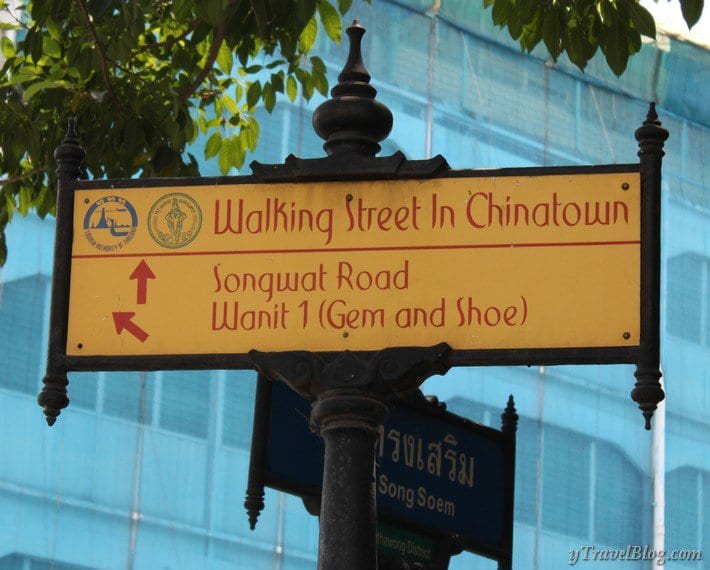
This post may contain affiliate links. We may receive a small commission, at no cost to you, if you make a purchase. Read Disclosure.
Chinatown is one of the most bustling areas of Bangkok and is usually highly listed on people’s itinerary.
It’s one of the oldest neighborhoods in the city, and is known as the largest China town in the world, so there’s no doubt it offers a unique contrast from the high-rise, spangly skyscrapers you see elsewhere.
If you’re looking for somewhere authentic and unique to spend your days in Bangkok, you should not miss a visit to the Chinatown district.
But Chinatown is huge, and it can feel overwhelming if you don’t know what to expect.
In this guide, we have covered all the top things to do in Chinatown, as well as sharing our tips, experiences, and some background knowledge, so you can enjoy your trip to Chinatown Bangkok with ease.
Is Chinatown Bangkok worth visiting?
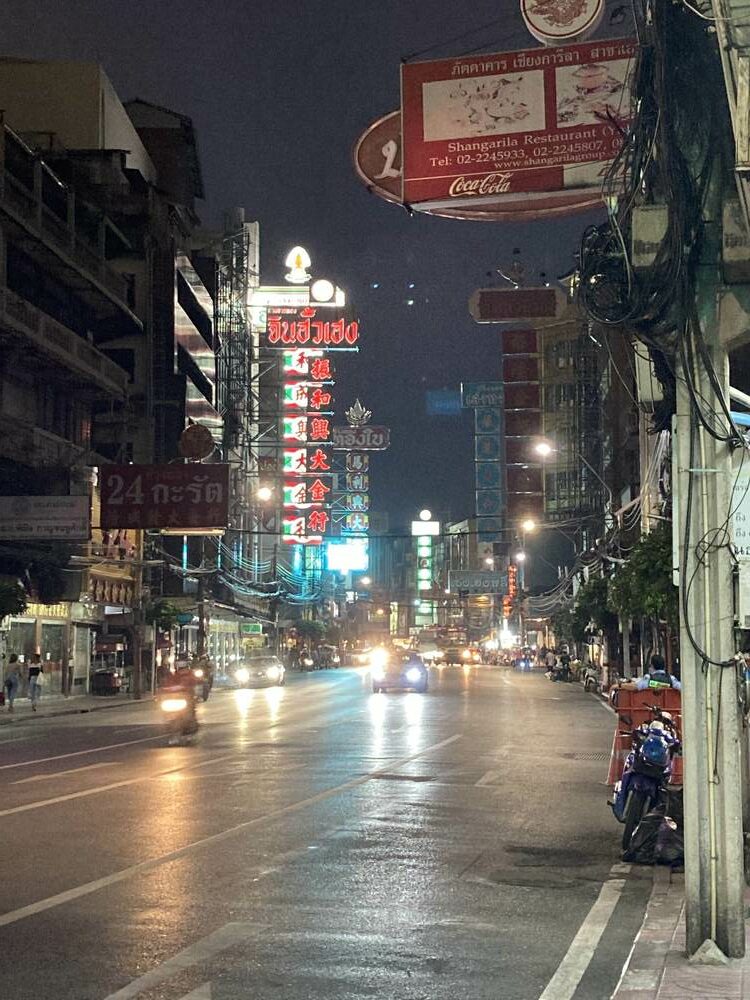
Chinatown is not a hidden gem, it’s well visited and draws millions of visitors there each year. As the largest Chinatown in the world, it can easily feel chaotic and busy, so if bustling isn’t your vibe then it’s not for you.
However, for the curious traveler, Chinatown in Bangkok is worth visiting as it’s one of the best places in Bangkok to find street food, it has a unique culture that’s unique to the rest of the city.
You’ll find busy markets filling the colorful and narrow alleys, authentic Chinese temples, Michelin-star dim sum restaurants, and lots of historic architecture from the 18th century.
Some people do find Chinatown to be overly touristy, and it’s definitely catering to tourists more, but I think it’s still retained much of its authentic Chinese charm.
History of Chinatown
Every major city in the world seems to have a Chinatown, but Bangkok has one of the largest Chinatowns in the world, spreading for 1.5 kilometers around Yaowarat Road.
The neighborhood was founded in 1782 when Bangkok was established as a city by King Taksin. Originally, it was home to the Teochew immigrants from China, but they quickly became the dominant ethnic group in the city.
The area was a huge commercial hub and the Chinese community prospered in trade, which bought more immigrants to the area.
The main thoroughfare is Yaowarat Road, which extends through the center of the neighborhood, but it extends into nearby areas such as Song Wat, Talat Noi, and as far as Charoen Krung Road.
The beating heart of Chinatown is Yaowarat Road, which is where you’ll find all the street food and restaurants. This is why locals sometimes refer to the Chinatown neighborhood simply as Yaowarat, because this street is the most bustling and famous for its neon signs.
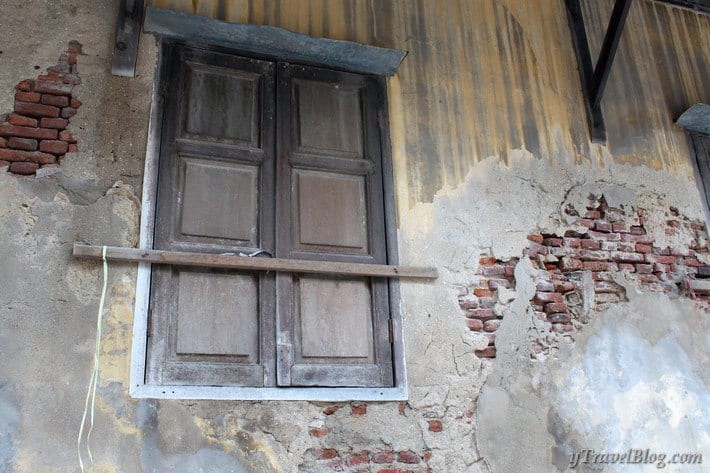
It’s also the name of the MRT station, should you be taking the MRT to get there.
Today, Chinatown still houses some Chinese residents, but its Chinese population has been declining in recent years.
Things to do in Chinatown Bangkok
If you’re planning a trip to Chinatown in Bangkok, here are all the top things to do and places to see in the neighborhood.
1. Take a walking tour
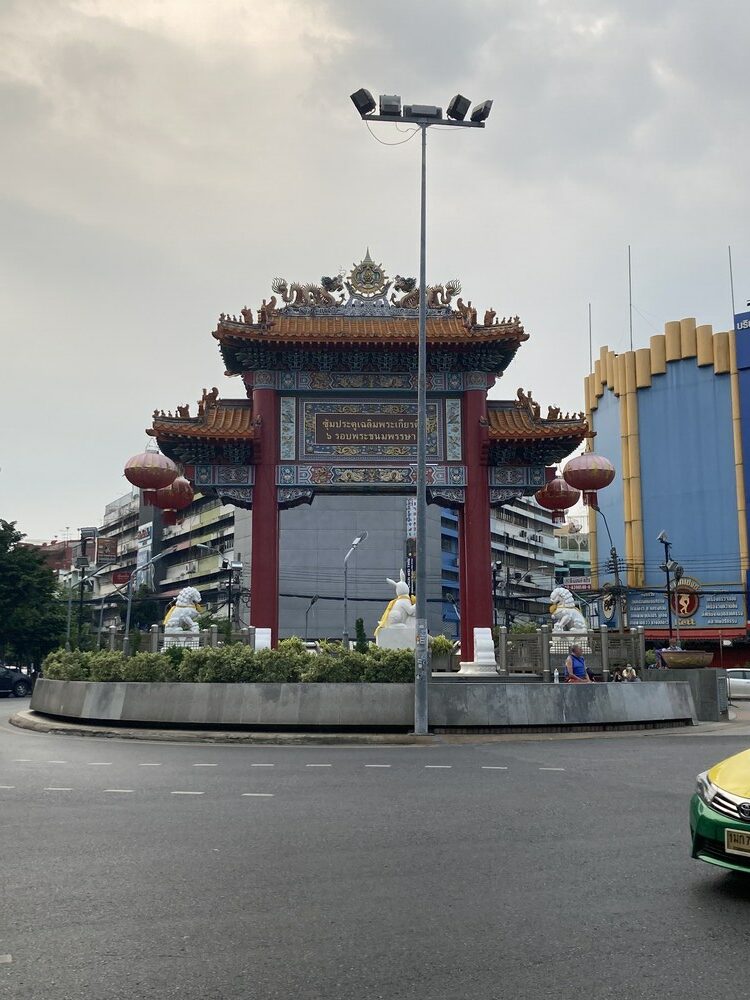
Craig and I lived near Golden Mountain on the outskirts of Chinatown when we lived in Bangkok, but despite living so close, our exploration was limited to a quick walk down to our favourite food stall of the evening for takeaway noodle gravy wrapped in butcher’s paper.
It was time to rectify some wrongs and properly explore the area, so we booked onto a walking tour.
I do believe one of the best ways to see Chinatown is by walking tour. As you follow a local guide, you get to learn about the history and culture of the area and see things that you might have otherwise missed.
We did a walking tour with Dragon Walking Tours, who are no longer operating, but it was a great experience and so we recommend you look out for other walking tours.
On our walking tour, we were welcomed as we entered the Chinatown gate. I’m hoping it sprinkled us with an extra dose of luck!
We were then shuttled down the the busy 1.5km Yaowarat Road, which weaves through the heart of Chinatown, creating the figure of a dragon on its way through.
Our walking tour then went through the food markets of the dragon’s body, down to the quieter walking streets of its tail resting in the Chao Praya River.
2. Shop in the “Dragon’s Belly” Market
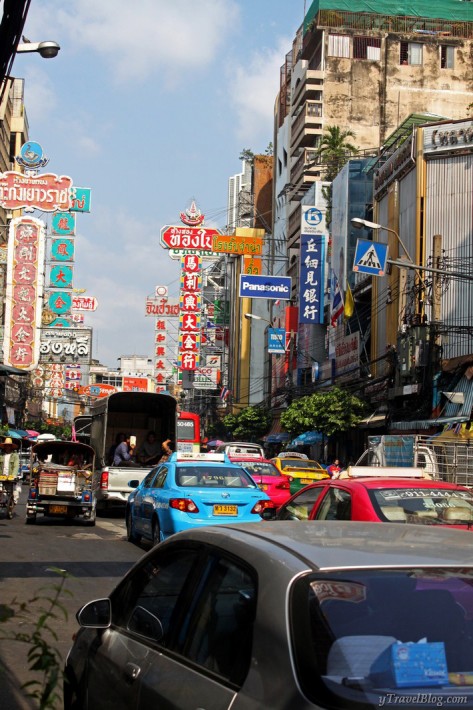
After the walking tour, we cross to enter the labyrinth of alleyways that is the dragon’s belly. The place of food and trade.
You don’t come here to shop however, you just need to witness it.
Chinatown is known for its chaotic traffic, but even in the tiny laneways, it’s no different. Vehicles and people struggle to push through the crowds to purchase their goods for their restaurant and store needs, or simply for the family meal this evening.
Bikers balance with two feet on the ground and move their mopeds through the alleyways bustling with locals buying their wares, ogling tourists, and cyclists tooting their whistles to make way for their overloaded bags of ice.
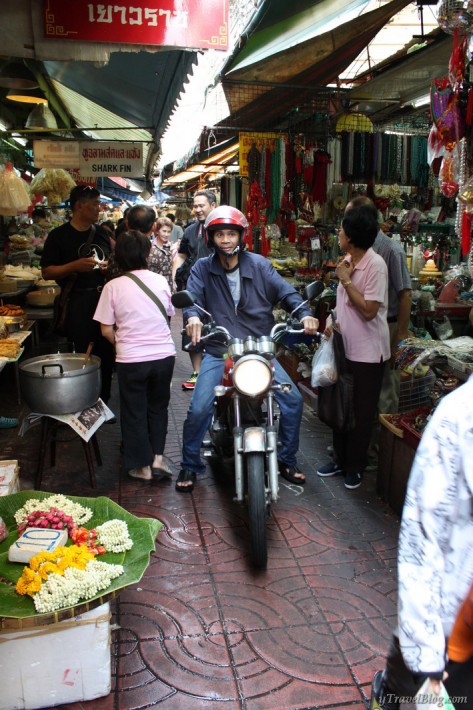 Beep Beep
Beep Beep
We continue to slow down the frenzied beat, jarring movement to take photos of tubs of tea, controversial shark fins, bowls of phallic sea cucumber, whole fish in iced buckets, and fruit with bees crawling all over them.
Flies devour the tofu that sits waiting for a happy eater to later devour it.
Irritated vendors step out from behind their bench to shoo, not the flies, but the pesky tourists, shouting “no photo” to anyone who tries to snap proof of the chaos.
Lowering the lens with an apologetic nod we move to turn right down another side street to move to the next photo opportunity.
The next laneway glows in red. Rows of Chinese lanterns and lucky tokens hang from the steel poles of the plastic roofs of the stalls.
I’m tempted to chat with the Chinese medicine doctor we pass sitting watch over his glass jars of herbs, spices, lotions and potions. “What magic and good fortune do you have for me today?“
The magic lies in exploring one of the oldest areas of Bangkok.
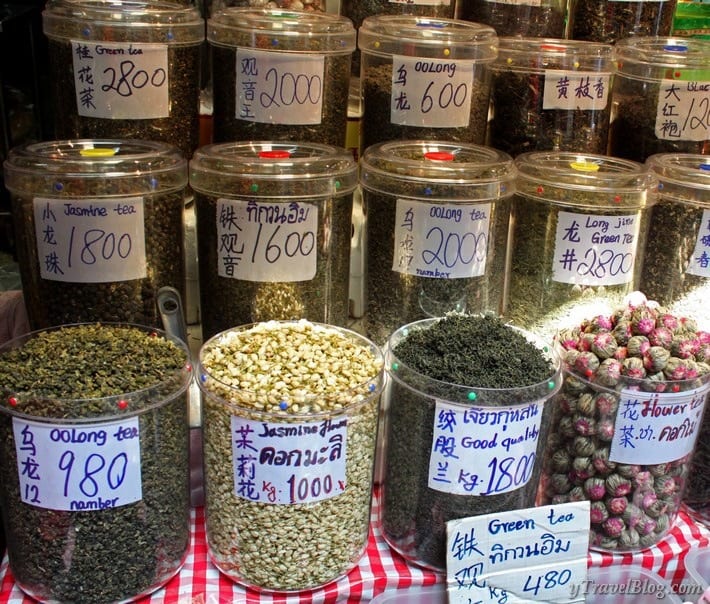 What’s your choice?
What’s your choice? 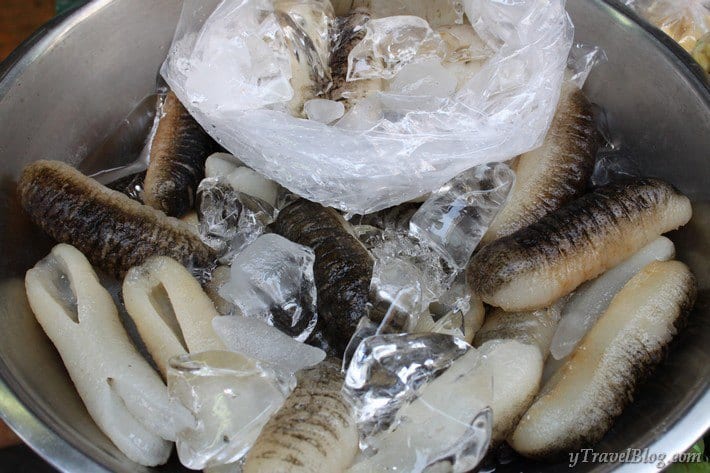 Sea cucumbers
Sea cucumbers 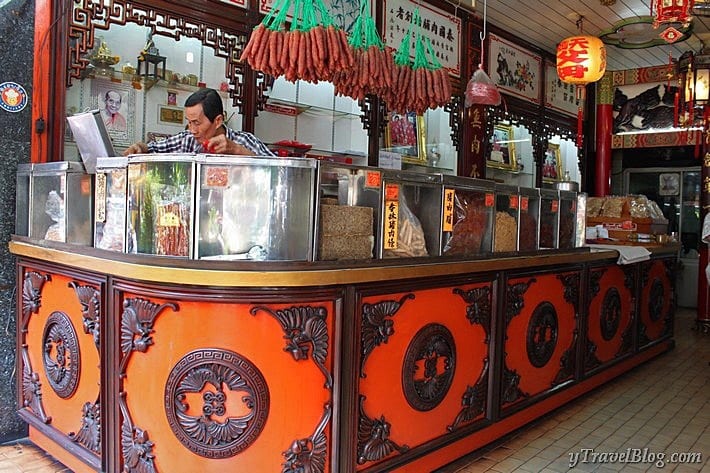 A cure for you
A cure for you
3. Stand back and watch the chaos
Chinatown buzzes with a frenetic activity that can overwhelm and frighten you if you don’t just let go to accept and embrace the madness.
The heart of Chinatown is not spared the chaos of Bangkok traffic.
Cars and buses spew forth choking-black smoke and fight for space on clogged roads; tuk-tuks sit idly at red lights anxious to be the first off the mark to burn around corners on one wheel; motorbikes dodge in and out pushing their way to the front and making everyone else seethe with jealousy (Well Thai people don’t really seethe).
It’s amazing to stand by on a pavement and simply watch the chaos. My Thai friend steered my elbow protectively as I wandered around it, like I am her five-year-old daughter.
I remember this is the Thai way and exchange my independence for gratitude.
4. Try Oyster Omelette – a Chinatown specialty
The belly of the dragon is full and pulsating, and after the heavy jostle through the crowds, it was time to start eating the food surrounding us.
If I had been on my own I would never have found my way out of the market maze to an eating place. The dragon’s luck remained with us in the shape of David Thompson, our ex-pat local guide for the day.
Australian-born Thompson owns the world-famous Michelin-starred Nahm restaurant in London and The Metropolitan on South Sathorn Road, Bangkok, and is an expert on Thai food.
He offered to show us the back roads of Chinatown, a place he loves to go to buy products for his own restaurants, to discover what lies in her hidden back alleyways, and to come in the early hours of the evening for a feed at any one of the restaurants that never sleep.
“If you find the right place, you will be in heaven. The food in Chinatown is excellent,” David says to us.
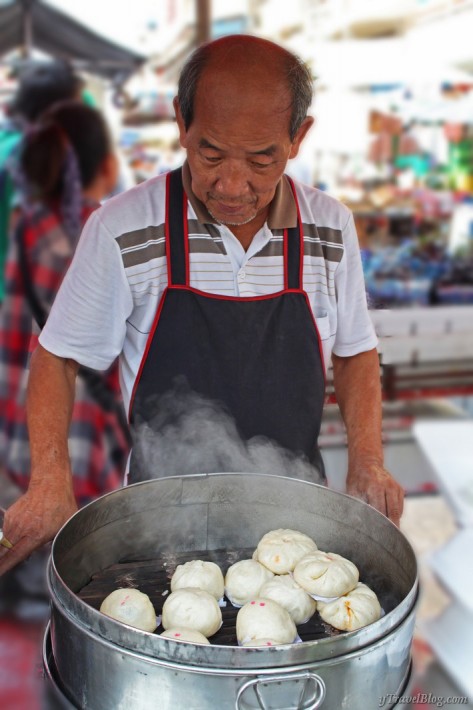 Dumpling?
Dumpling?
The right place was one of David’s favourite Chinatown dishes, an oyster omelette. He leads us to an unassuming hole in the wall, Nai Mong Hoi Nang Tort at Talad Gao.
The chef stands over his wok at the entrance to the small restaurant, the oyster omelette shrouding him in a haze of smoke.
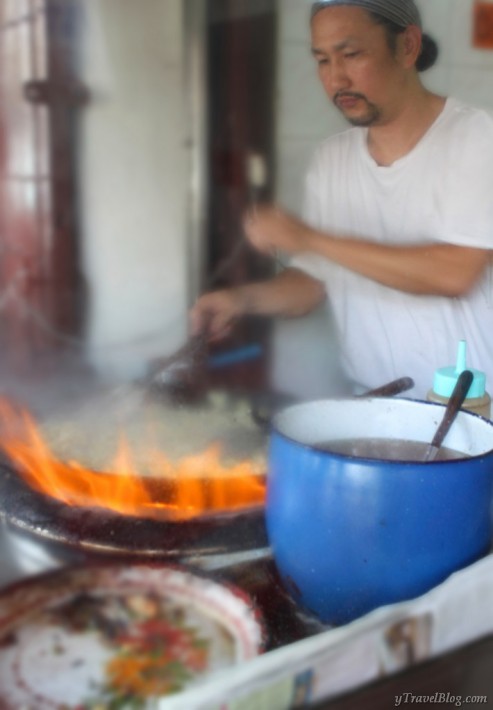
He reaches for the eggs, cracks them and starts the process of creation again, never breaking his rhythm to stop and smile or talk.
I like an oyster or two, and an omelette once or twice a year. The omelette was stuffed with oysters and garnished on top with another handful. The chili sauce did little to tone down the overbearing flavour and I turned to my sprite to help wash it down.

I was happy to leave and continue walking through the dragon’s belly, under the electrical wires that dangle across the streets like strings of spaghetti.
5. Find Peace Amongst the Chinatown Chaos
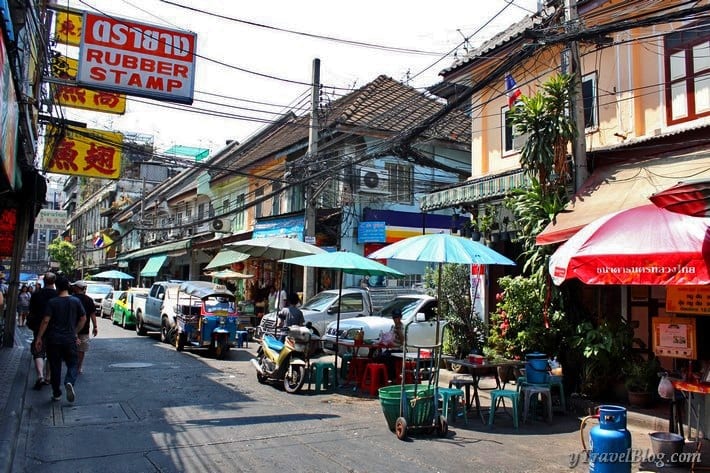
A white-robed nun sits outside the wall of a Chinese temple squashed in the small alleyway. The tables of the food stall hugging the temple walls are filled, no one noticing the nun nodding with sleep and nearly toppling off her chair.
An elderly man pushes me “keep walking huh” he rasps rushing to spare space in the corner behind me hocking up his clogged chest onto the ground.
Spitting, hocking up, and smoking over the bags of food is a common sight and sound.
I stand on the street taking a photo of an old Chinese building opposite. A car waits patiently for me to finish so he can move on.
There is no honking of the horn, no middle finger or head leaning out the window calling me a nasty name as you would hear within two seconds in Australia.
People have learned to live with the chaos and to make space for everyone in their lives. There is a rhythm of consideration and peace that people in Bangkok gently move through.
6. Hike The Dragon’s Tail (Songwat Road)

The fullness of the belly soon spews us out into the tail. The street is much wider with cars passing by only now and then. I relax with a sigh.
It is Song Wat St, one of the oldest streets in Bangkok. Signs point to walking street and I wonder if that is where we came from, where we are going, or where we now are.
The air is much freer here. There’s no fear of being run over by a motorbike or hocked up on by a phlegmatic elder.
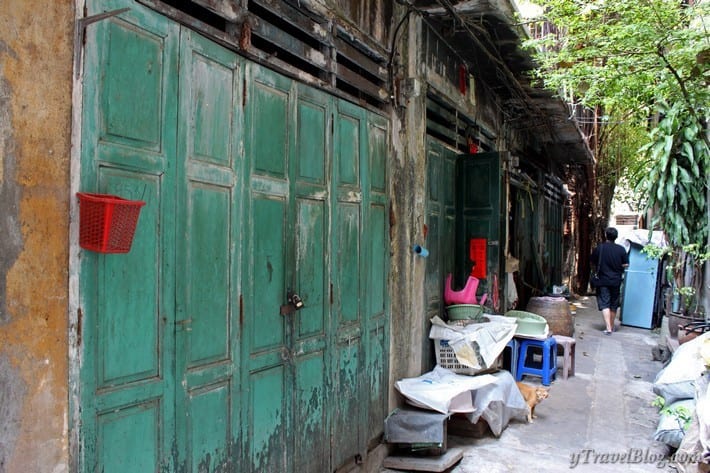 The ancient part of Chinatown Bangkok
The ancient part of Chinatown Bangkok
David takes us down side streets that have laneways running off them; places I’d never find without our guide or the willingness of my feet to get lost.
Down a small alley lies an ancient crumbling building; gnarled and knotted roots of trees ensnare it trying to lay reclaim the land that was once their own.
Chanting prayers ring out over the fence. Our gaze turns up to a window of the modern white building behind it; bodies stand and then drop in unison with the calls of worship.
I forget it is Friday, the Muslim Holy Day, and that I am a woman in short shorts. I wander around the back of the mosque to explore the cemetery and tranquil gardens behind it.
My senses return and I scurry back out on the street before my luck diminishes, bowing my head apologetically to the men washing their hands outside in preparation for their Friday salah.
The chanting slowly dies away as the tail of the dragon flicks us to the river, the end of our walk exploring the Bangkok dragon.
 Chinatown mosque
Chinatown mosque 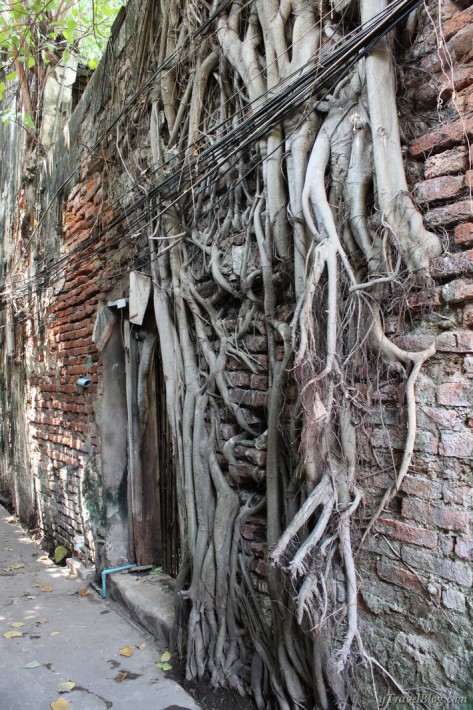
Chinatown bustles with diversity and the richness of living. It’s an explosion of sensory discovery and an area of Bangkok that offers a different insight into the depths of Thai culture.
7. Gorge on Street Food
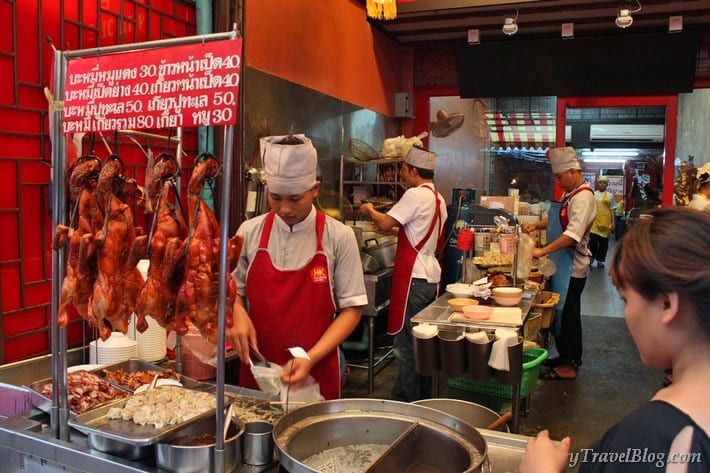
Chinatown is most famous for its gastronomy, so it would be a shame to visit without trying some street food.
The food you’ll find here is not like the usual street food you’ll find in the rest of the city such as mango sticky rice, you’re more likely to find more Chinese influences such as shark-fin soup (usually not real shark fin anymore) and shrimp dumplings. For desserts, try tofu dessert, it’s delicious!
For amazing seafood, visit Lek & Rut Seafood Stall, which gives you a huge portion for a small price.
You’ll find many street food vendors in the markets and lining Yaowarat Road.
Another popular place to visit for food in Chinatown is Nai Ek Roll Noodle, which has been operating since 1960, and has some of the best pork noodle soup.
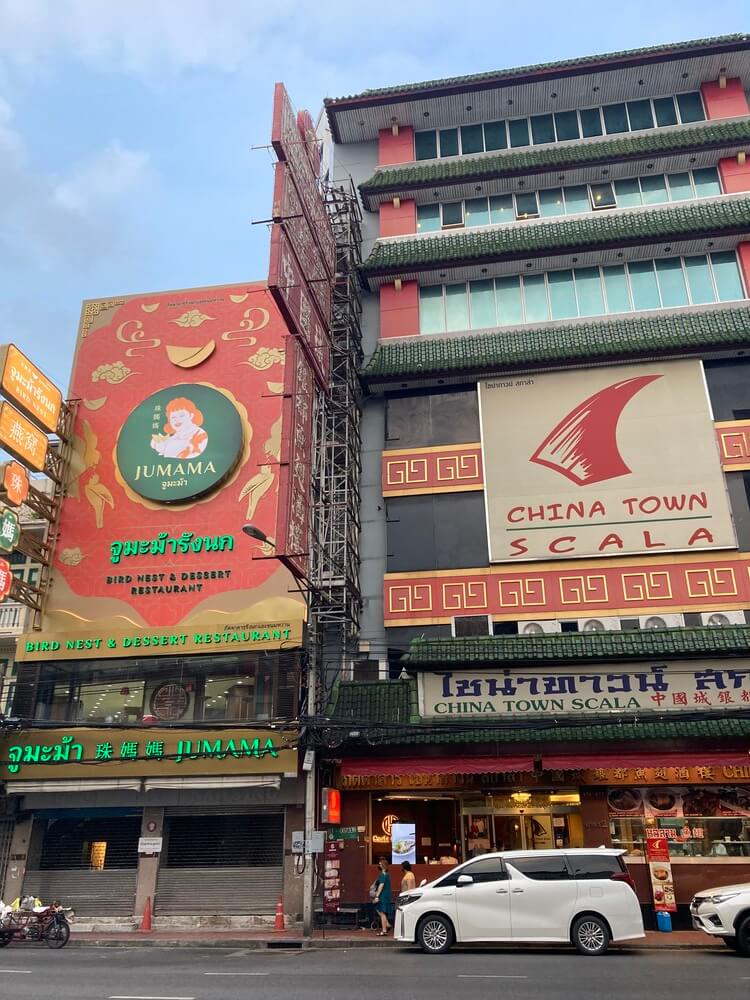
8. Visit the Chinese Temples
One of the most famous temples in Chinatown is Wat Chakrawatrachawat Woramahawihan, better known as the Crocodile Temple.
The crocodiles who live here are safely enclosed in a pond after it was said they used to eat young monks.
Another temple worth visiting is Wat Mangkon Kamalawat, or in English, Dragon Lotus Temple or Dragon Flower Temple.
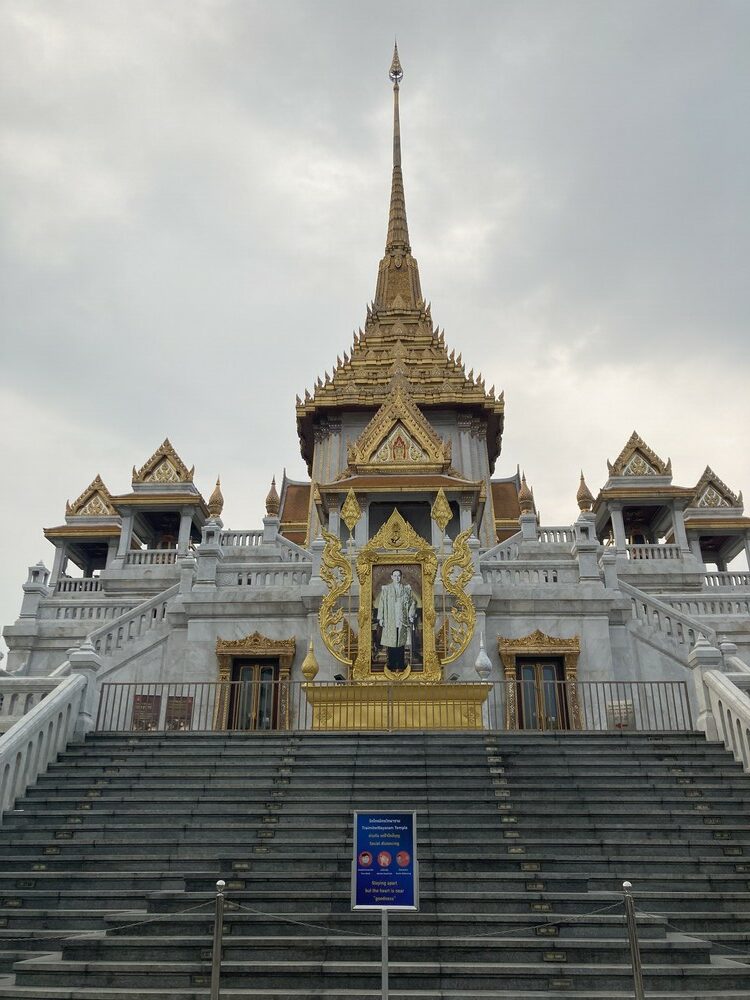
This is the largest and most important Chinese Buddhist temple in Bangkok. It’s most famous for hosting events, such as Chinese New Year festivities and the Chinese Vegetarian Festival.
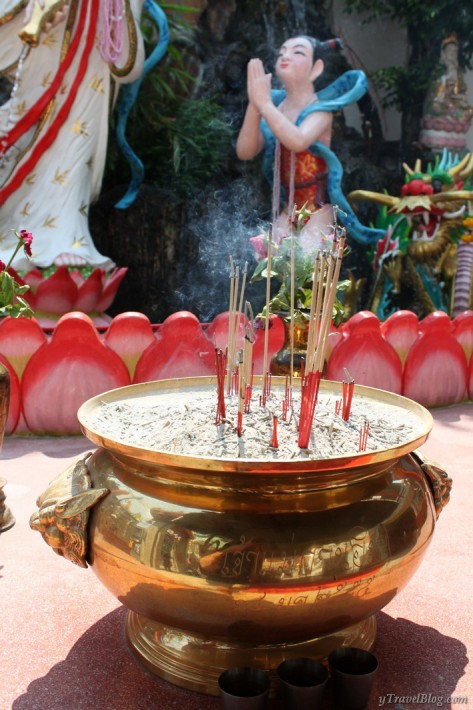 Chinese temple
Chinese temple
If you want to see a temple with stunning golden shrines, be sure to see the Temple of the Golden Buddha at Wat Traimit, in the samphanthawong district, near the China Gate. It has the largest gold Buddha statue in the world, weighing 5.5 tonnes!
9. Visit Sampeng Lane Market
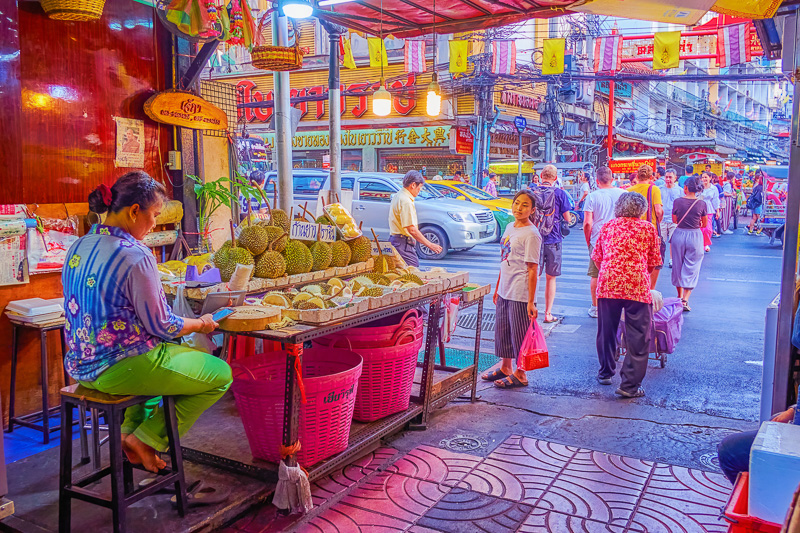 Sampeng Lane Market
Sampeng Lane Market
Another good reason to visit Chinatown in Bangkok is for the markets. The Sampeng Lane Market is the oldest market in Chinatown and is packed from floor to ceiling with stalls.
It’s a daytime market that sells everything you can think of, from souvenirs to shoes, to unique Asian gadgets and handicrafts. Many people shop for items in bulk here, which explains why everything is stacked on top of each other making it difficult to browse.
You can also find traditional goods here, such as fabrics and Asian snacks.
Walking down the alleyways of the market it can feel claustrophobic with all the amounts of goods on sale, but it’s all part of the fun.
The market is open from 8am – 5pm every day except Sunday, when it closes at 2pm.
10. Get dessert from Shanghai Moon (Yaowarat)
Chinese desserts are some of the most delicious in the world, and great for health conscious people who don’t want to gorge on anything too sweet.
Most Chinese desserts are made with tofu, soy bean, waterchestnut, beans or taro, sago or ginger…or a combination of all of them, and served with a sweet milk or milk tea.
Shanghai Moon, which is just around the corner from the MRT, is a great place to sample Chinese desserts.
I personally love the black sesame dumplings with grinko nuts and ginger soup, but that’s just me! The salted egg bua loy gets raved about a lot too.
Getting to Chinatown
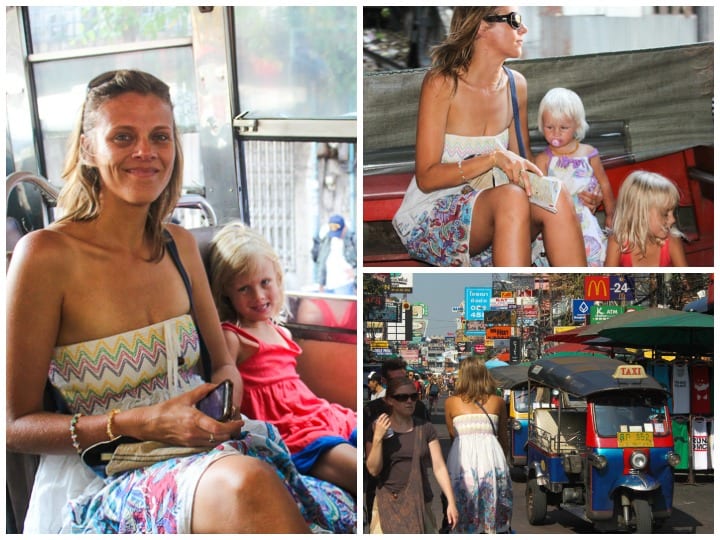
The easiest way to get to Chinatown is to take the MRT to Wat Mangkon and walk for five minutes. This will put you in the center of Chinatown, and from here it’s easy to explore West to East.
One of the top attractions in Chinatown is the Ong Ang Walking Street, which actually starts near Sam Yot MRT station. If you want to see the whole street, you could start here and walk down. Wear walking shoes though, it’s a long way!
A more fun way to reach Chinatown is by boat. You can get a water taxi from most areas along the Chao Phraya River by the water, and get off at the Ratchawong Pier. From here you can walk to many of the top attractions in Chinatown.
Read this guide on getting around Bangkok and exploring Bangkok via the klongs.
FAQs about visiting Chinatown Bangkok
If you’ve never been before, here are some commonly asked questions…
What time does Chinatown close in Bangkok?
If you visit on a Monday, you may think this guide has been mistaken for somewhere else. This is because the street stores don’t open on Mondays as this is the official street cleaning day in Bangkok. Although Chinatown doesn’t close, you will find Monday to be very quiet because of the lack of street food stalls, and most markets and shops tend to close too. Market stalls tend to close around 6pm each day, whereas restaurants stay open until 10:30pm.
What is the best time of day to go to Chinatown in Bangkok?
The best time to go to Chinatown in Bangkok is about 4pm, so you can visit the markets and temples, and wander around for a couple of hours before the street food stalls open. Remember that the street food stalls won’t open on Mondays.
Is Chinatown a good area to stay in Bangkok?
You might be wondering if you should book a hotel in Chinatown, and this wouldn’t be a bad option. Chinatown is close to the Chaya Praya River, and is on an MRT line, which easily connects you to other parts of the city. You can also walk to Bangkok Train Station that takes you to Ayutthaya from Chinatown and it has a lot of places to eat nearby. It’s an affordable, lively option.
Is there a BTS near Chinatown in Bangkok?
No, there is no BTS in Chinatown in Bangkok. The nearest BTS station is National Stadium, which is a 40-minute walk away. However, it is on the MRT line, which is a convenient mode of transport to get around the city.
Before You Go
Chinatown is a vibrant district in Bangkok and one of the most captivating and unique. It still retains much of its original heritage and the street food there is some of the best in the city.
Before you go, be sure to wear walking shoes as there is a lot to see and do here, and the neighborhood is big! Make sure you also carry cash, as many of the street food stalls do not take card.
And above all, have the best time in Chinatown! We have an easy to follow 3 day Bangkok itinerary guide for you!
More Travel Tips for Bangkok
Are you in need of more inspiration for your trip to Bangkok? Then you may enjoy these guides:
Are you planning a visit to China Town in Bangkok? Let us know if you experience chaos or peace in the comments!
Please visit:
Our Sponsor
